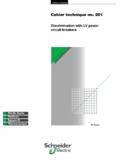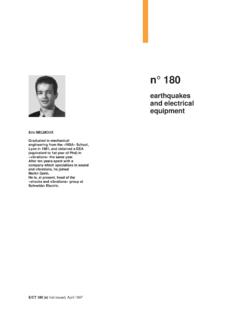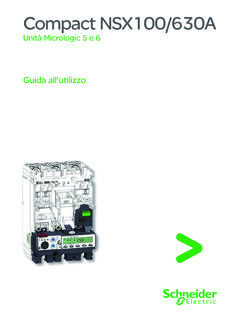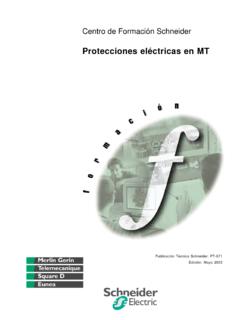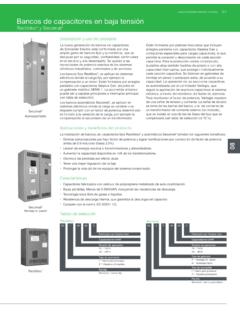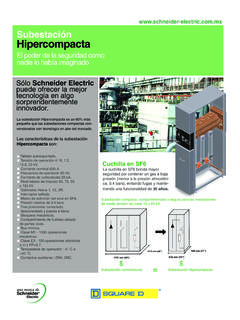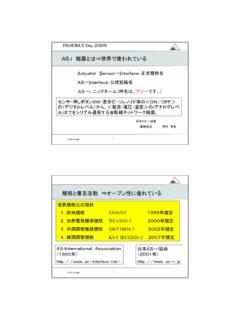Transcription of Cahier technique n 145 - studiecd.dk
1 Collection TechniqueCahier technique n 145 Thermal study of LV electricswitchboardsC. Kilindjiann Merlin Gerin n Square D n TelemecaniqueCahiers Techniques are a collection of documents intended for engineersand technicians people in the industry who are looking for information ingreater depth in order to complement that given in display Cahiers Techniques go beyond this stage and constitute praticaltraining contain data allowing to design and implement electrical equipement,industrial electronics and electrical transmission and Cahier technique provides an in-depth study of a precise subject inthe fields of electrical networks, protection devices, monitoring and controland industrial automation latest publications can be downloaded on Internet from theSchneider : :mastering electrical powerPlease contact your Schneider representative if you want either a CahierTechnique or the list of available Cahiers Techniques collection is part of the Groupe Schneider s Collection technique .
2 ForewordThe author disclaims all responsibility further to incorrect use of informationor diagrams reproduced in this document, and cannot be held responsiblefor any errors or oversights, or for the consequences of using informationand diagrams contained in this of all or part of a Cahier technique is authorised with theprior consent of the Scientific and Technical Division. The statement Extracted from Schneider Cahier technique (please specify) KILINDJIANA fter graduating as an engineer from the Ecole Sup rieure d'Energieet des Mat riaux of Orl ans in 1986, he then joined Merlin Gerin in thissame year as part of the Technical Section in the Low VoltageSwitchboards for basic studies, he specialises in problems of heatexchanges and electrodynamic withstand in LV is currently working in the Anticipation departent of the LowVoltage Power Compartments SBS as an expert on thermal problemsin LV circuit-breaker and equipment 145 Thermal study of LV electricswitchboardsE/CT 145 first issued, december 1997 Cahier technique Schneider n 145 / technique Schneider n 145 / Controlling thermal phenomena in LV cubiclesp.
3 42 Thermal problems in a Causes - effects and solutionsp. Taking stock of standardsp. Briefeview of the main thermal phenomenap. Exchanges at switchboard levelp. 104 Presentation of Principlep. Modelling convectionp. Application to LV enclosuresp. Busbarsp. Switchgear devicesp. Principlep. Description of the data to be provided and of the resultsobtainedp. Modelled configurationsp. Resultsp. Experimentl resultsp. 217 Method proposed by the IEC 890 reportp. 228 Conclusionp. 243 Thermal behaviour of a LV electricswitchboard5 Behaviour of heat sources andcharacteristicsThermal study of LV electricswitchboardsThis Cahier technique aims at furthering the understanding and masteryof the thermal problems encountered in LV electric a brief review of standards and of thermal phenomena.
4 Conduction -radiation - convection, the author shows how LV cubicles can be modelledusing modelling techniques normally reserved for other naturally leads to software to aid design of electrical cubiclesequipped with results are compared with real temperature , the methods and possibilities of the IEC 890 guide are Method for calculating temperature inenvelopes and experimental resultsCahier technique Schneider n 145 / Controlling thermal phenomena in LV cubiclesMastery of its operation requires knowledge andcontrol not only of the functioning of itscomponents but also of the external influences towhich they are electric switchboard is the combination of 4basic elements:c the envelope,c the switchgear,c the connections,c the functions performing indication, control andprocessing of switchboards are increasingly technicaland require a certain number of basic studies inorder to master, in the design stage, theoperating conditions of its components in aspecific area covered by such studies is the thermalaspects which form the subject matter of this Cahier technique .
5 The new manufacturing methods developed inindustry in recent years (just in ) havebrought a new notion to light: industrialdependability. This concept which covers twodifferent aspects, safety of persons andequipment, and availability of electrical power,shows when it is applied to complex processes,the critical points whose operation must bethoroughly electric switchboard is one of thesecritical that the problem is similar for considered as a simple passing point,it has become the genuine nerve centre ofelectrical installations. The safety of the entireinstallation and thus of all industrial and tertiaryactivities relies on its technique Schneider n 145 / 1: thermal problems in terms of cause and Improve ventilation ofroom and/or switchboardc Adequately sizedswitchboardc Adequately Supports with goodelectrodynamic at high T c Tightness Temperature Adequately Review choice ofcomponents temperature toohighHigh diversity or overloadLoose connectionsConductor cross-sectiontoo smallDevice derating error orincorrect positioningEffectsc Switchboard internaltemperature too highc Tripping of thermalreleasesc Ageing of electronicsc Temperature ofenclosure walls too highc Tripping of switchboardincoming protectionc Switchboard internaltemperature too highc Temperature ofenclosure walls too highc Damaged conductorsc Damaged insulated barsupportsc Device conductorsdestroyedc Conductors destroyedc Abnormal operation(tripping)
6 C Premature ageingProtectionc Alarmc Automatic fan startupc Load sheddingc Safety trippingc Uncertain upstreamtrippingc Nonec Tripping or indicationCan occur insome caseseven whendesignedaccording andmaintenanceproblemsInstallationdesign errorError in choiceor use ofdeviceIEC439 IEC634 IEC898 IEC9472 Thermal problems in a switchboardThree main reasons make thermal masteryincreasingly vital. These reasons are:c The tendency to place electrical equipment inenvelopes (for safety purposes) which areincreasingly made of insulating material (poorcalory dissipation capacity).c Progress of switchgear which includes moreand more electronic components of increasinglycompact The tendency to fill switchboards to their limitand an increasing bulk factor (ratio between thenominal current of the switchboard incomingcircuit-breaker and the sum of nominal feedercurrents.)
7 This factor is also known as thediversity factor). Causes, effects and solutionsThe temperature of an electrical device is theresult of:c the Joule effect (P = R I2), of its withstandto current flow,c ambient switchgear is designed in accordancewith manufacturing standards which define themaximum temperatures not to exceed to ensuresafety of persons: temperature of case and ofswitching devices, maximum temperaturedeviation for terminals; this is verified by productcertification devices function in a wide variety of workingconditions in switchboards, the causes ofexcessive temperature are (see Figure 1) shows the main causes,their effects and the possible technique Schneider n 145 / problem in fact consists of ensuring, onswitchboard design, that all its components willoperate in temperature conditions that are lessrestrictive than those laid down by theirconstruction standards.
8 The scheduled currentmust obviously be able to flow through theconnection switchgear (circuit-breakers,contactors, ) without any addition to safety of persons and equipment,two other objectives must be considered:c availability of electrical power (no untimelyoperation or failure to operate),c lifetime of conclusion, the challenge consists ofanticipating with a high degree of certainty thethermal operating state of the types of solutions can be identified:c the panel builder's experience,c the real tests for repetitive switchboards,c the use of software which can determine,according to envelope characteristics, thecurrent strength/temperature pair for each heatsource (switchgear - conductors) (seeparagraph 4), in accordance with their positionand with the temperature of the surrounding is obvious that a software validated byexperience and tests is of great use as it allowscomparative study of the many possibleinstallation configurations and thus optimisationof the future switchboard as regards thermalaspects Taking stock of standardsMany standards cover the Low Voltage area, forexample the NF C 15-100 for France whichdefines the rules to be complied with for allLV regards definition and design of LV devicesand assemblies, the following can be referred torespectively:c Switchgear standards, IEC The IEC 439 standard for LV cubicles(assemblies).
9 The IEC 439 international standardis divided into three parts:v IEC which contains the rules for typetested assemblies and for partially type testedassemblies,v IEC which defines the rules forprefabricated ducts,v The IEC draft standard which coversLV switchgear assemblies installed in placesaccessible to untrained part particularly of interest to us forLV switchboards is IEC edited in the European context, this standard acts as astructural framework for most national standards(British Standard, NF C, ) whose contentsare a fairly accurate copy of the text of theIEC standard in which differences correspondrather to the country's specific practices than toquestioning of fundamental points of theIEC France this is the case of the NF C main contribution of this standard has beena more accurate definition of two notions aimingat increased safety.
10 These notions are:c That of Totally Tested Assemblies, TTA (typetested assembly) or of Partially Type TestedAssemblies, The notion of forms (see fig. 2).Without going into detail, we can say that theTTA correspond to products that are completelydefined and frozen both as regards theircomponents (exact drawings of eachcomponent) and manufacturing ( ) and which have to meet type tests(temperature rise, short-circuit, continuity ) laid down by the PTTA correspond to assemblies whosebasic structure is a TTA to which one or moremodifications have been made which must bevalidated either by calculation or by a notion of forms corresponds to a precisedefinition of the degrees of separation that canbe found in a switchboard and which increaseprotection of persons by inaccessibility to liveparts ( ). Four types of forms can beidentified ranging from total absence ofseparation (form 1) to complete partitioning ofthe various switchboard elements (form 4).



